Disruptive Innovations and the DSLR Camera Market: A Case Study
VerifiedAdded on 2021/04/16
|84
|20501
|117
Thesis and Dissertation
AI Summary
This dissertation investigates the impact of disruptive innovations and business models on the DSLR camera market, with a specific focus on the influence of high-end smartphones. The study examines how the introduction of advanced camera technology in smartphones has disrupted the traditional DSLR market, mirroring the historical disruption of film cameras by DSLRs. The research employs a mixed methodology, combining primary data collected through surveys and secondary data from published sources. The findings analyze the demographic data, subjective responses, and cross-tabulations to assess the impact of smartphone cameras on the DSLR market. The dissertation also explores the technological differences and affordability factors between DSLRs and smartphones. The conclusion links the findings to the research objectives, providing recommendations, discussing limitations, and suggesting areas for future research. The research aims to understand the evolving landscape of the photography industry and the challenges and opportunities faced by DSLR manufacturers in the face of smartphone innovation.
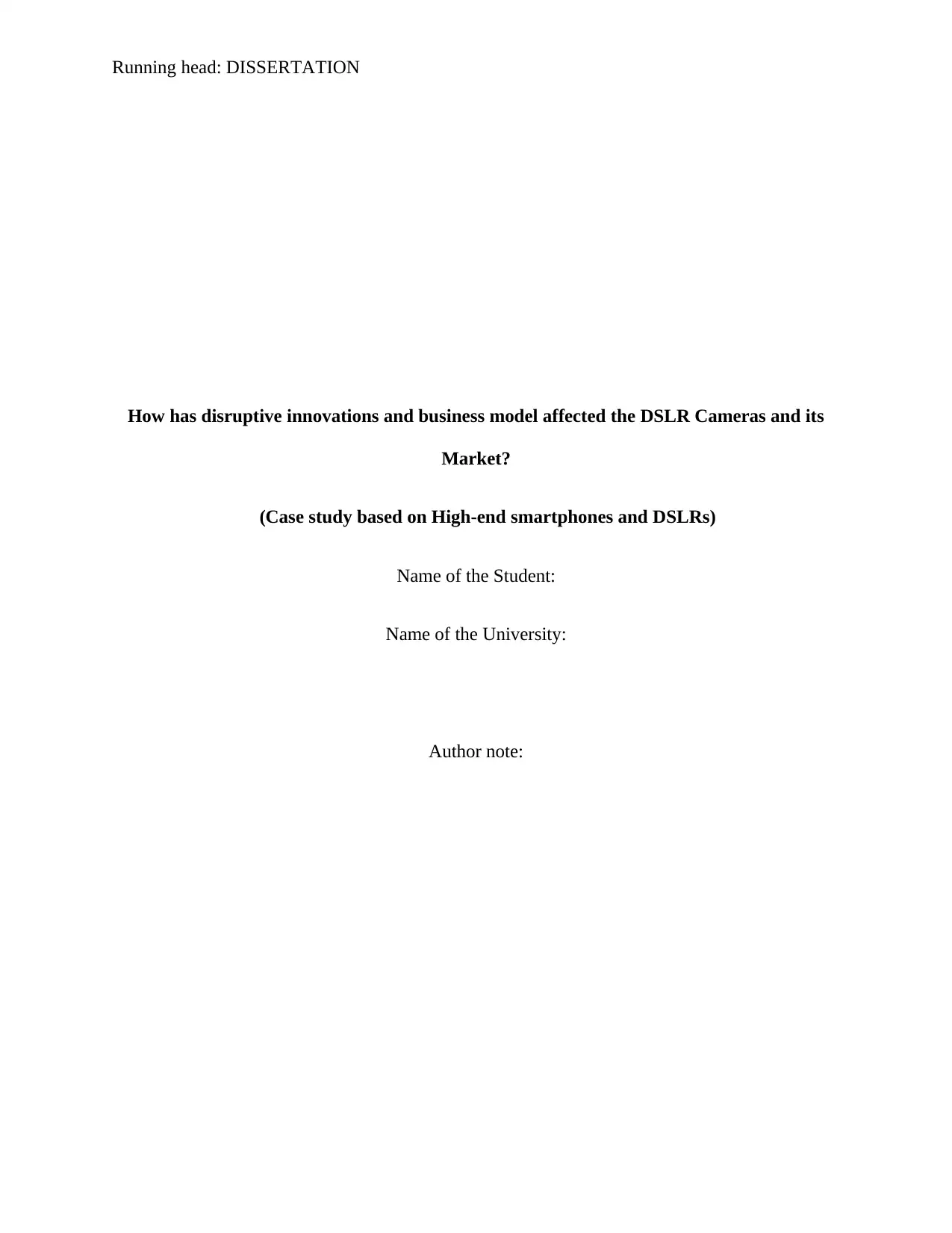
Running head: DISSERTATION
How has disruptive innovations and business model affected the DSLR Cameras and its
Market?
(Case study based on High-end smartphones and DSLRs)
Name of the Student:
Name of the University:
Author note:
How has disruptive innovations and business model affected the DSLR Cameras and its
Market?
(Case study based on High-end smartphones and DSLRs)
Name of the Student:
Name of the University:
Author note:
Paraphrase This Document
Need a fresh take? Get an instant paraphrase of this document with our AI Paraphraser

1
DISSERTATIONAcknowledgement
I would like to express my gratitude towards all those people who have helped me immensely
during the course of my study. Firstly, I would like to thank my supervisor, who had guided me
and supported me in every step of the entire research study in such a manner that I could not only
gain in-depth knowledge about my course of study, but also about the relevance of learning,
which would help me in my life even in the future. I would also like to thank the participants,
who willingly take part in my primary data collection process to give their valuable inputs
regarding the research topic. I am grateful to the librarians who helped me in collecting
secondary data for the research study. Lastly, I would like to say thanks to my friends and
family, without whose support has helped me to push my boundaries further in completing the
study in the best possible and timely manner.
DISSERTATIONAcknowledgement
I would like to express my gratitude towards all those people who have helped me immensely
during the course of my study. Firstly, I would like to thank my supervisor, who had guided me
and supported me in every step of the entire research study in such a manner that I could not only
gain in-depth knowledge about my course of study, but also about the relevance of learning,
which would help me in my life even in the future. I would also like to thank the participants,
who willingly take part in my primary data collection process to give their valuable inputs
regarding the research topic. I am grateful to the librarians who helped me in collecting
secondary data for the research study. Lastly, I would like to say thanks to my friends and
family, without whose support has helped me to push my boundaries further in completing the
study in the best possible and timely manner.
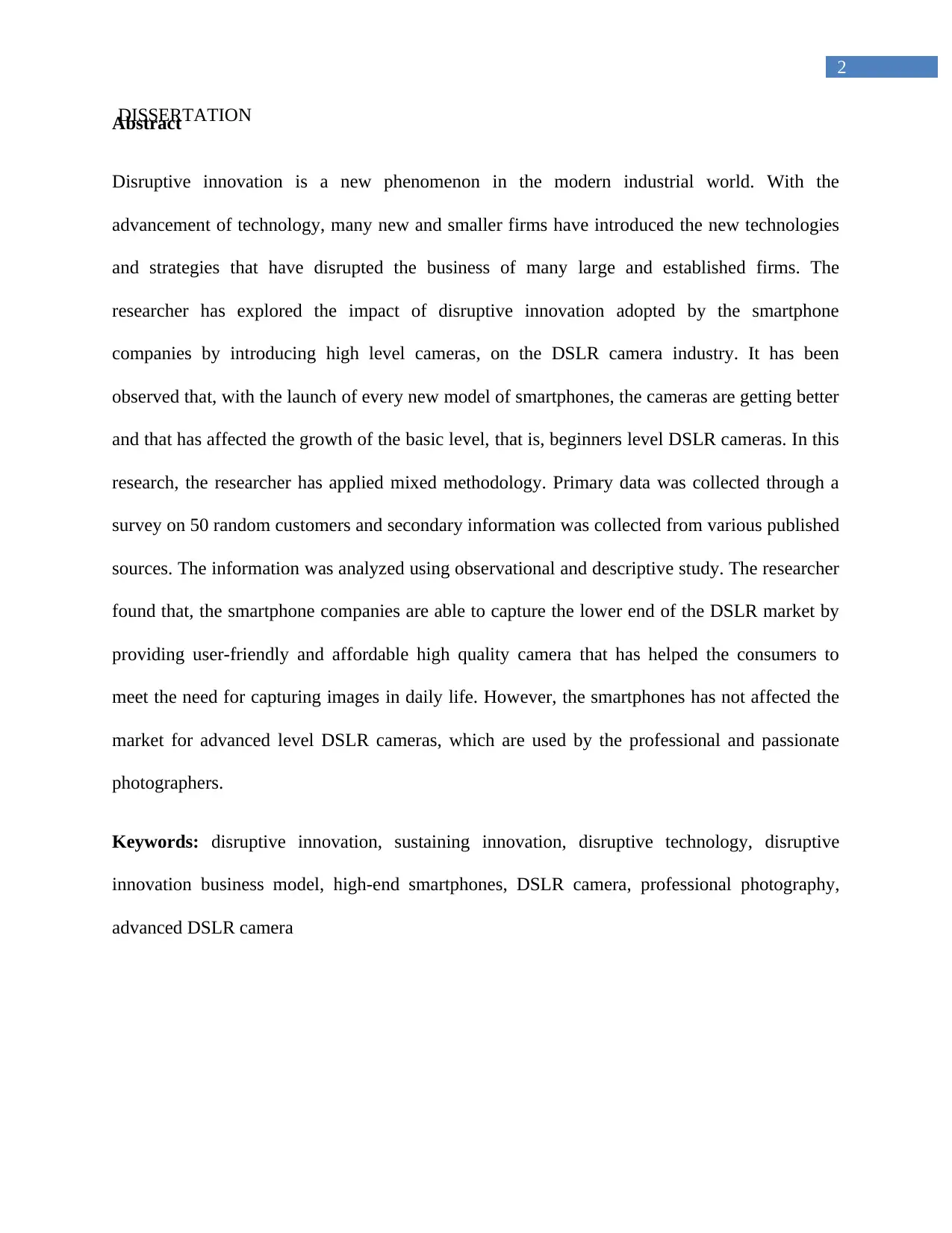
2
DISSERTATIONAbstract
Disruptive innovation is a new phenomenon in the modern industrial world. With the
advancement of technology, many new and smaller firms have introduced the new technologies
and strategies that have disrupted the business of many large and established firms. The
researcher has explored the impact of disruptive innovation adopted by the smartphone
companies by introducing high level cameras, on the DSLR camera industry. It has been
observed that, with the launch of every new model of smartphones, the cameras are getting better
and that has affected the growth of the basic level, that is, beginners level DSLR cameras. In this
research, the researcher has applied mixed methodology. Primary data was collected through a
survey on 50 random customers and secondary information was collected from various published
sources. The information was analyzed using observational and descriptive study. The researcher
found that, the smartphone companies are able to capture the lower end of the DSLR market by
providing user-friendly and affordable high quality camera that has helped the consumers to
meet the need for capturing images in daily life. However, the smartphones has not affected the
market for advanced level DSLR cameras, which are used by the professional and passionate
photographers.
Keywords: disruptive innovation, sustaining innovation, disruptive technology, disruptive
innovation business model, high-end smartphones, DSLR camera, professional photography,
advanced DSLR camera
DISSERTATIONAbstract
Disruptive innovation is a new phenomenon in the modern industrial world. With the
advancement of technology, many new and smaller firms have introduced the new technologies
and strategies that have disrupted the business of many large and established firms. The
researcher has explored the impact of disruptive innovation adopted by the smartphone
companies by introducing high level cameras, on the DSLR camera industry. It has been
observed that, with the launch of every new model of smartphones, the cameras are getting better
and that has affected the growth of the basic level, that is, beginners level DSLR cameras. In this
research, the researcher has applied mixed methodology. Primary data was collected through a
survey on 50 random customers and secondary information was collected from various published
sources. The information was analyzed using observational and descriptive study. The researcher
found that, the smartphone companies are able to capture the lower end of the DSLR market by
providing user-friendly and affordable high quality camera that has helped the consumers to
meet the need for capturing images in daily life. However, the smartphones has not affected the
market for advanced level DSLR cameras, which are used by the professional and passionate
photographers.
Keywords: disruptive innovation, sustaining innovation, disruptive technology, disruptive
innovation business model, high-end smartphones, DSLR camera, professional photography,
advanced DSLR camera
⊘ This is a preview!⊘
Do you want full access?
Subscribe today to unlock all pages.

Trusted by 1+ million students worldwide
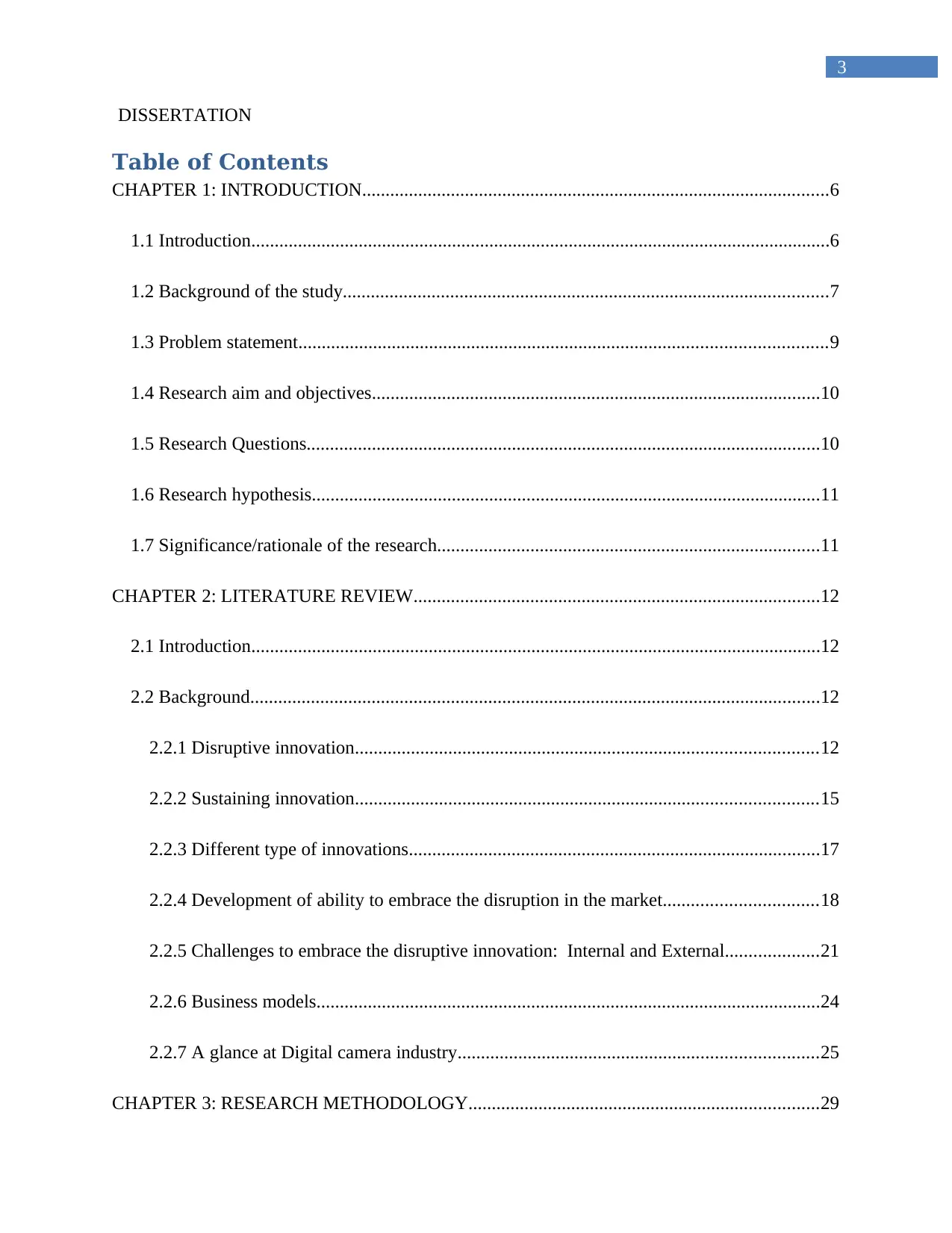
3
DISSERTATION
Table of Contents
CHAPTER 1: INTRODUCTION....................................................................................................6
1.1 Introduction............................................................................................................................6
1.2 Background of the study........................................................................................................7
1.3 Problem statement.................................................................................................................9
1.4 Research aim and objectives................................................................................................10
1.5 Research Questions..............................................................................................................10
1.6 Research hypothesis.............................................................................................................11
1.7 Significance/rationale of the research..................................................................................11
CHAPTER 2: LITERATURE REVIEW.......................................................................................12
2.1 Introduction..........................................................................................................................12
2.2 Background..........................................................................................................................12
2.2.1 Disruptive innovation...................................................................................................12
2.2.2 Sustaining innovation...................................................................................................15
2.2.3 Different type of innovations........................................................................................17
2.2.4 Development of ability to embrace the disruption in the market.................................18
2.2.5 Challenges to embrace the disruptive innovation: Internal and External....................21
2.2.6 Business models............................................................................................................24
2.2.7 A glance at Digital camera industry.............................................................................25
CHAPTER 3: RESEARCH METHODOLOGY...........................................................................29
DISSERTATION
Table of Contents
CHAPTER 1: INTRODUCTION....................................................................................................6
1.1 Introduction............................................................................................................................6
1.2 Background of the study........................................................................................................7
1.3 Problem statement.................................................................................................................9
1.4 Research aim and objectives................................................................................................10
1.5 Research Questions..............................................................................................................10
1.6 Research hypothesis.............................................................................................................11
1.7 Significance/rationale of the research..................................................................................11
CHAPTER 2: LITERATURE REVIEW.......................................................................................12
2.1 Introduction..........................................................................................................................12
2.2 Background..........................................................................................................................12
2.2.1 Disruptive innovation...................................................................................................12
2.2.2 Sustaining innovation...................................................................................................15
2.2.3 Different type of innovations........................................................................................17
2.2.4 Development of ability to embrace the disruption in the market.................................18
2.2.5 Challenges to embrace the disruptive innovation: Internal and External....................21
2.2.6 Business models............................................................................................................24
2.2.7 A glance at Digital camera industry.............................................................................25
CHAPTER 3: RESEARCH METHODOLOGY...........................................................................29
Paraphrase This Document
Need a fresh take? Get an instant paraphrase of this document with our AI Paraphraser
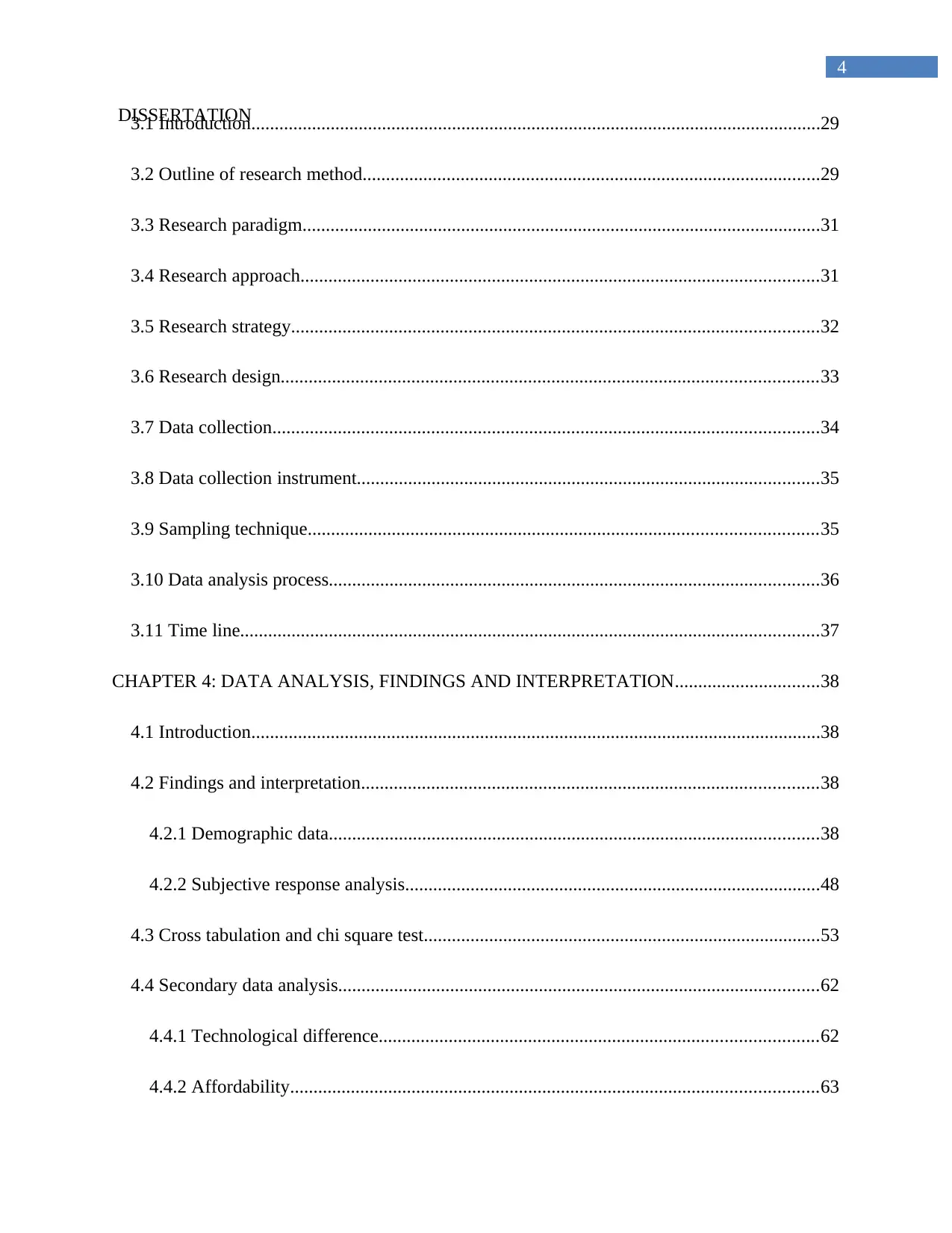
4
DISSERTATION3.1 Introduction..........................................................................................................................29
3.2 Outline of research method..................................................................................................29
3.3 Research paradigm...............................................................................................................31
3.4 Research approach...............................................................................................................31
3.5 Research strategy.................................................................................................................32
3.6 Research design...................................................................................................................33
3.7 Data collection.....................................................................................................................34
3.8 Data collection instrument...................................................................................................35
3.9 Sampling technique.............................................................................................................35
3.10 Data analysis process.........................................................................................................36
3.11 Time line............................................................................................................................37
CHAPTER 4: DATA ANALYSIS, FINDINGS AND INTERPRETATION...............................38
4.1 Introduction..........................................................................................................................38
4.2 Findings and interpretation..................................................................................................38
4.2.1 Demographic data.........................................................................................................38
4.2.2 Subjective response analysis.........................................................................................48
4.3 Cross tabulation and chi square test.....................................................................................53
4.4 Secondary data analysis.......................................................................................................62
4.4.1 Technological difference..............................................................................................62
4.4.2 Affordability.................................................................................................................63
DISSERTATION3.1 Introduction..........................................................................................................................29
3.2 Outline of research method..................................................................................................29
3.3 Research paradigm...............................................................................................................31
3.4 Research approach...............................................................................................................31
3.5 Research strategy.................................................................................................................32
3.6 Research design...................................................................................................................33
3.7 Data collection.....................................................................................................................34
3.8 Data collection instrument...................................................................................................35
3.9 Sampling technique.............................................................................................................35
3.10 Data analysis process.........................................................................................................36
3.11 Time line............................................................................................................................37
CHAPTER 4: DATA ANALYSIS, FINDINGS AND INTERPRETATION...............................38
4.1 Introduction..........................................................................................................................38
4.2 Findings and interpretation..................................................................................................38
4.2.1 Demographic data.........................................................................................................38
4.2.2 Subjective response analysis.........................................................................................48
4.3 Cross tabulation and chi square test.....................................................................................53
4.4 Secondary data analysis.......................................................................................................62
4.4.1 Technological difference..............................................................................................62
4.4.2 Affordability.................................................................................................................63
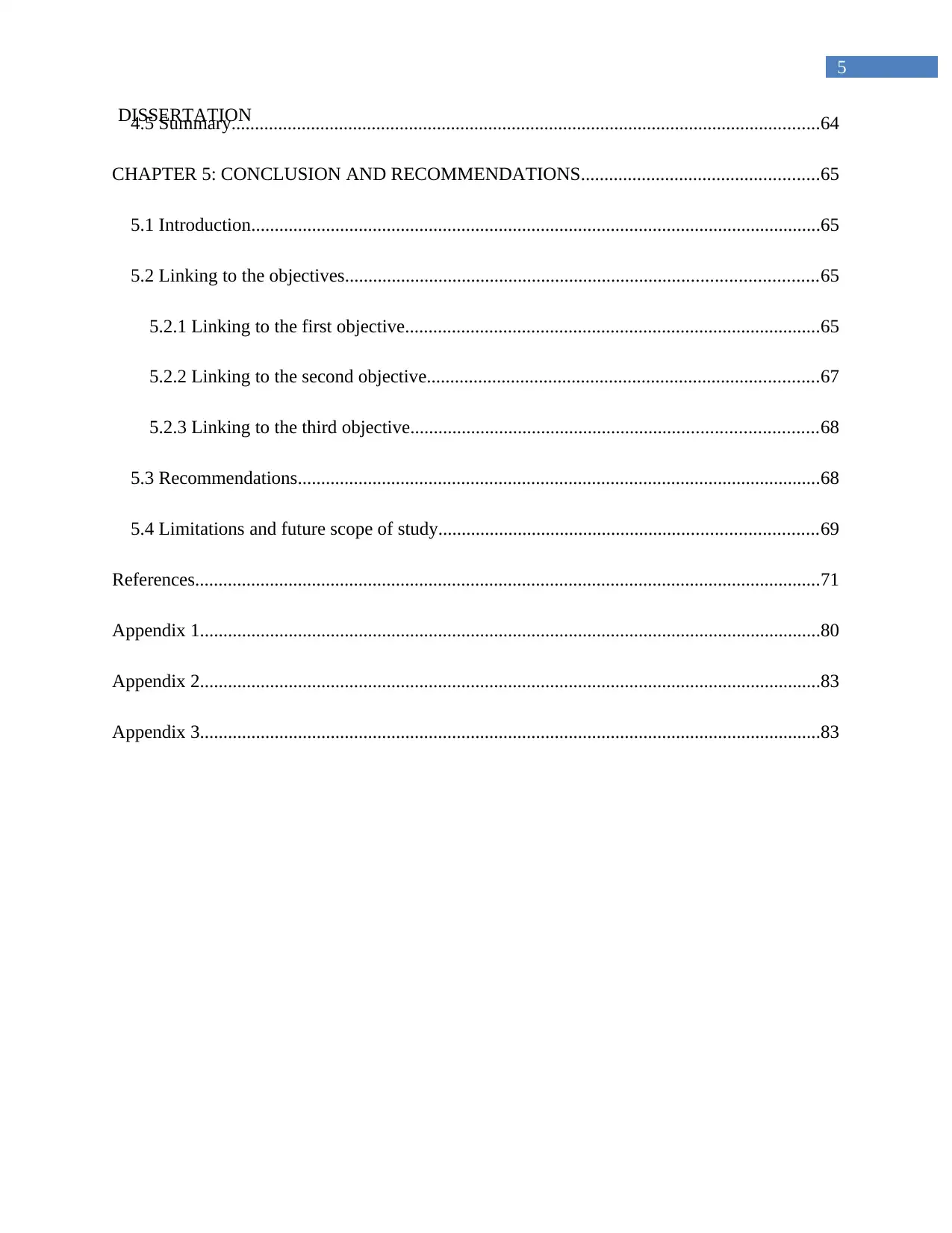
5
DISSERTATION4.5 Summary..............................................................................................................................64
CHAPTER 5: CONCLUSION AND RECOMMENDATIONS...................................................65
5.1 Introduction..........................................................................................................................65
5.2 Linking to the objectives.....................................................................................................65
5.2.1 Linking to the first objective.........................................................................................65
5.2.2 Linking to the second objective....................................................................................67
5.2.3 Linking to the third objective.......................................................................................68
5.3 Recommendations................................................................................................................68
5.4 Limitations and future scope of study.................................................................................69
References......................................................................................................................................71
Appendix 1.....................................................................................................................................80
Appendix 2.....................................................................................................................................83
Appendix 3.....................................................................................................................................83
DISSERTATION4.5 Summary..............................................................................................................................64
CHAPTER 5: CONCLUSION AND RECOMMENDATIONS...................................................65
5.1 Introduction..........................................................................................................................65
5.2 Linking to the objectives.....................................................................................................65
5.2.1 Linking to the first objective.........................................................................................65
5.2.2 Linking to the second objective....................................................................................67
5.2.3 Linking to the third objective.......................................................................................68
5.3 Recommendations................................................................................................................68
5.4 Limitations and future scope of study.................................................................................69
References......................................................................................................................................71
Appendix 1.....................................................................................................................................80
Appendix 2.....................................................................................................................................83
Appendix 3.....................................................................................................................................83
⊘ This is a preview!⊘
Do you want full access?
Subscribe today to unlock all pages.

Trusted by 1+ million students worldwide
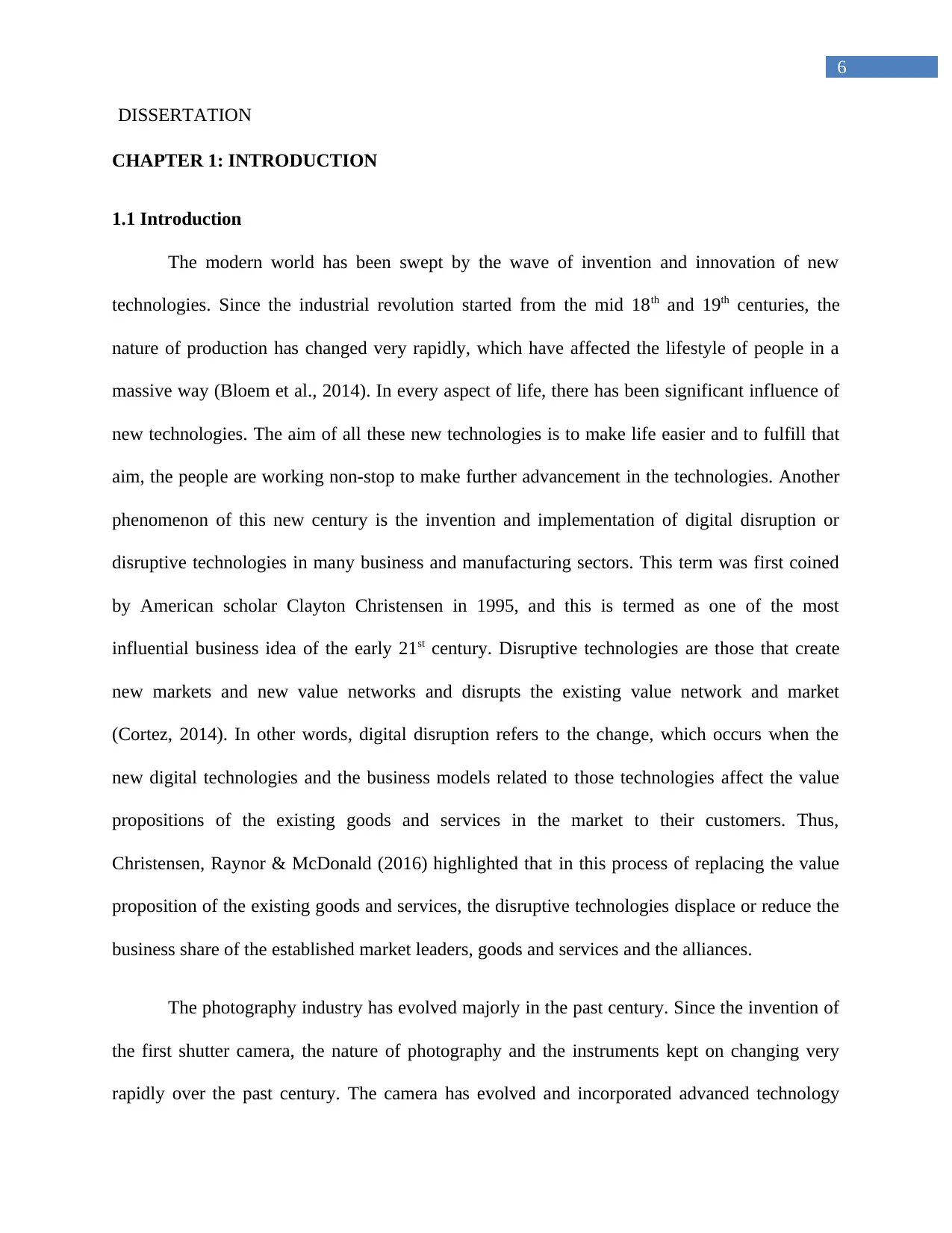
6
DISSERTATION
CHAPTER 1: INTRODUCTION
1.1 Introduction
The modern world has been swept by the wave of invention and innovation of new
technologies. Since the industrial revolution started from the mid 18th and 19th centuries, the
nature of production has changed very rapidly, which have affected the lifestyle of people in a
massive way (Bloem et al., 2014). In every aspect of life, there has been significant influence of
new technologies. The aim of all these new technologies is to make life easier and to fulfill that
aim, the people are working non-stop to make further advancement in the technologies. Another
phenomenon of this new century is the invention and implementation of digital disruption or
disruptive technologies in many business and manufacturing sectors. This term was first coined
by American scholar Clayton Christensen in 1995, and this is termed as one of the most
influential business idea of the early 21st century. Disruptive technologies are those that create
new markets and new value networks and disrupts the existing value network and market
(Cortez, 2014). In other words, digital disruption refers to the change, which occurs when the
new digital technologies and the business models related to those technologies affect the value
propositions of the existing goods and services in the market to their customers. Thus,
Christensen, Raynor & McDonald (2016) highlighted that in this process of replacing the value
proposition of the existing goods and services, the disruptive technologies displace or reduce the
business share of the established market leaders, goods and services and the alliances.
The photography industry has evolved majorly in the past century. Since the invention of
the first shutter camera, the nature of photography and the instruments kept on changing very
rapidly over the past century. The camera has evolved and incorporated advanced technology
DISSERTATION
CHAPTER 1: INTRODUCTION
1.1 Introduction
The modern world has been swept by the wave of invention and innovation of new
technologies. Since the industrial revolution started from the mid 18th and 19th centuries, the
nature of production has changed very rapidly, which have affected the lifestyle of people in a
massive way (Bloem et al., 2014). In every aspect of life, there has been significant influence of
new technologies. The aim of all these new technologies is to make life easier and to fulfill that
aim, the people are working non-stop to make further advancement in the technologies. Another
phenomenon of this new century is the invention and implementation of digital disruption or
disruptive technologies in many business and manufacturing sectors. This term was first coined
by American scholar Clayton Christensen in 1995, and this is termed as one of the most
influential business idea of the early 21st century. Disruptive technologies are those that create
new markets and new value networks and disrupts the existing value network and market
(Cortez, 2014). In other words, digital disruption refers to the change, which occurs when the
new digital technologies and the business models related to those technologies affect the value
propositions of the existing goods and services in the market to their customers. Thus,
Christensen, Raynor & McDonald (2016) highlighted that in this process of replacing the value
proposition of the existing goods and services, the disruptive technologies displace or reduce the
business share of the established market leaders, goods and services and the alliances.
The photography industry has evolved majorly in the past century. Since the invention of
the first shutter camera, the nature of photography and the instruments kept on changing very
rapidly over the past century. The camera has evolved and incorporated advanced technology
Paraphrase This Document
Need a fresh take? Get an instant paraphrase of this document with our AI Paraphraser
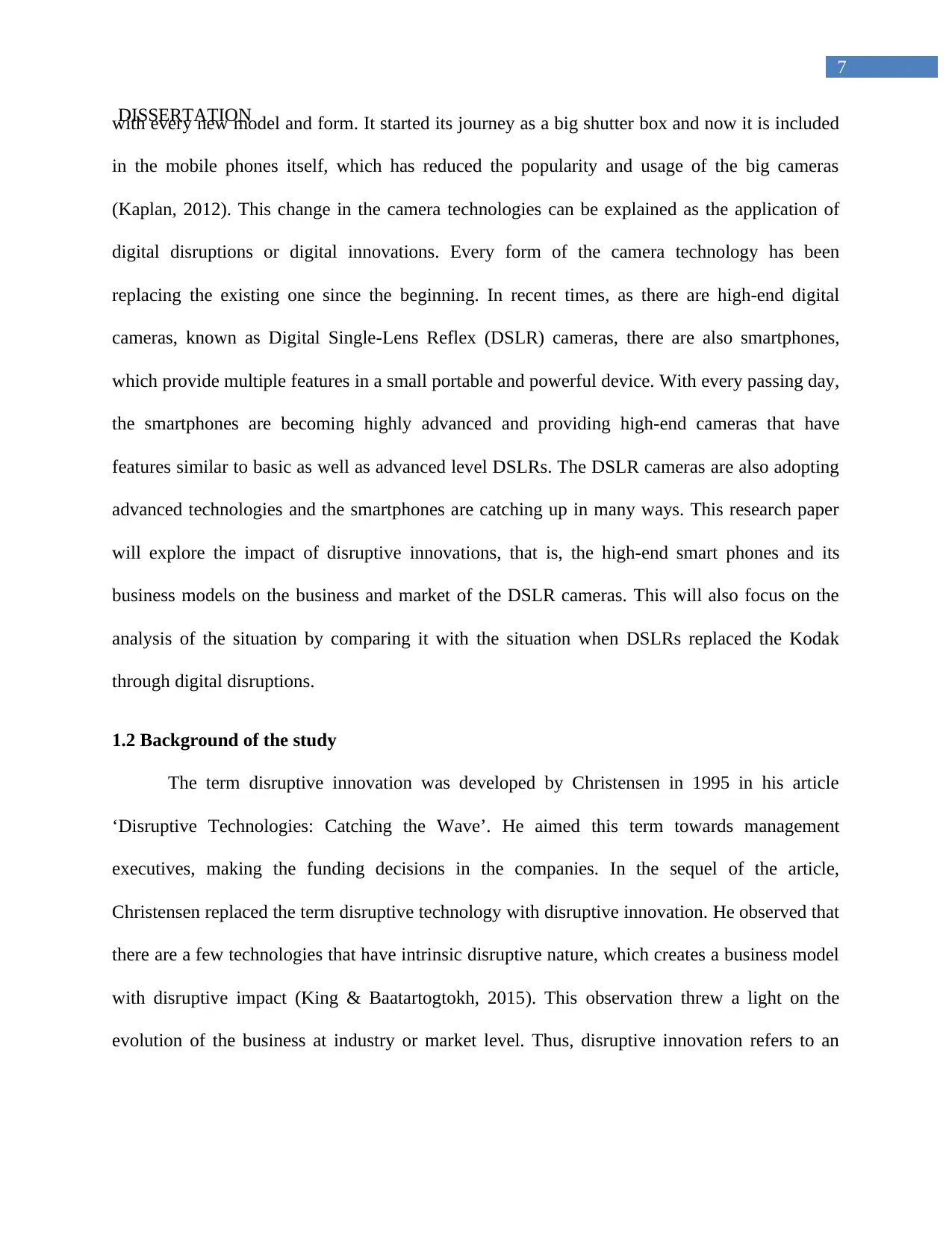
7
DISSERTATIONwith every new model and form. It started its journey as a big shutter box and now it is included
in the mobile phones itself, which has reduced the popularity and usage of the big cameras
(Kaplan, 2012). This change in the camera technologies can be explained as the application of
digital disruptions or digital innovations. Every form of the camera technology has been
replacing the existing one since the beginning. In recent times, as there are high-end digital
cameras, known as Digital Single-Lens Reflex (DSLR) cameras, there are also smartphones,
which provide multiple features in a small portable and powerful device. With every passing day,
the smartphones are becoming highly advanced and providing high-end cameras that have
features similar to basic as well as advanced level DSLRs. The DSLR cameras are also adopting
advanced technologies and the smartphones are catching up in many ways. This research paper
will explore the impact of disruptive innovations, that is, the high-end smart phones and its
business models on the business and market of the DSLR cameras. This will also focus on the
analysis of the situation by comparing it with the situation when DSLRs replaced the Kodak
through digital disruptions.
1.2 Background of the study
The term disruptive innovation was developed by Christensen in 1995 in his article
‘Disruptive Technologies: Catching the Wave’. He aimed this term towards management
executives, making the funding decisions in the companies. In the sequel of the article,
Christensen replaced the term disruptive technology with disruptive innovation. He observed that
there are a few technologies that have intrinsic disruptive nature, which creates a business model
with disruptive impact (King & Baatartogtokh, 2015). This observation threw a light on the
evolution of the business at industry or market level. Thus, disruptive innovation refers to an
DISSERTATIONwith every new model and form. It started its journey as a big shutter box and now it is included
in the mobile phones itself, which has reduced the popularity and usage of the big cameras
(Kaplan, 2012). This change in the camera technologies can be explained as the application of
digital disruptions or digital innovations. Every form of the camera technology has been
replacing the existing one since the beginning. In recent times, as there are high-end digital
cameras, known as Digital Single-Lens Reflex (DSLR) cameras, there are also smartphones,
which provide multiple features in a small portable and powerful device. With every passing day,
the smartphones are becoming highly advanced and providing high-end cameras that have
features similar to basic as well as advanced level DSLRs. The DSLR cameras are also adopting
advanced technologies and the smartphones are catching up in many ways. This research paper
will explore the impact of disruptive innovations, that is, the high-end smart phones and its
business models on the business and market of the DSLR cameras. This will also focus on the
analysis of the situation by comparing it with the situation when DSLRs replaced the Kodak
through digital disruptions.
1.2 Background of the study
The term disruptive innovation was developed by Christensen in 1995 in his article
‘Disruptive Technologies: Catching the Wave’. He aimed this term towards management
executives, making the funding decisions in the companies. In the sequel of the article,
Christensen replaced the term disruptive technology with disruptive innovation. He observed that
there are a few technologies that have intrinsic disruptive nature, which creates a business model
with disruptive impact (King & Baatartogtokh, 2015). This observation threw a light on the
evolution of the business at industry or market level. Thus, disruptive innovation refers to an
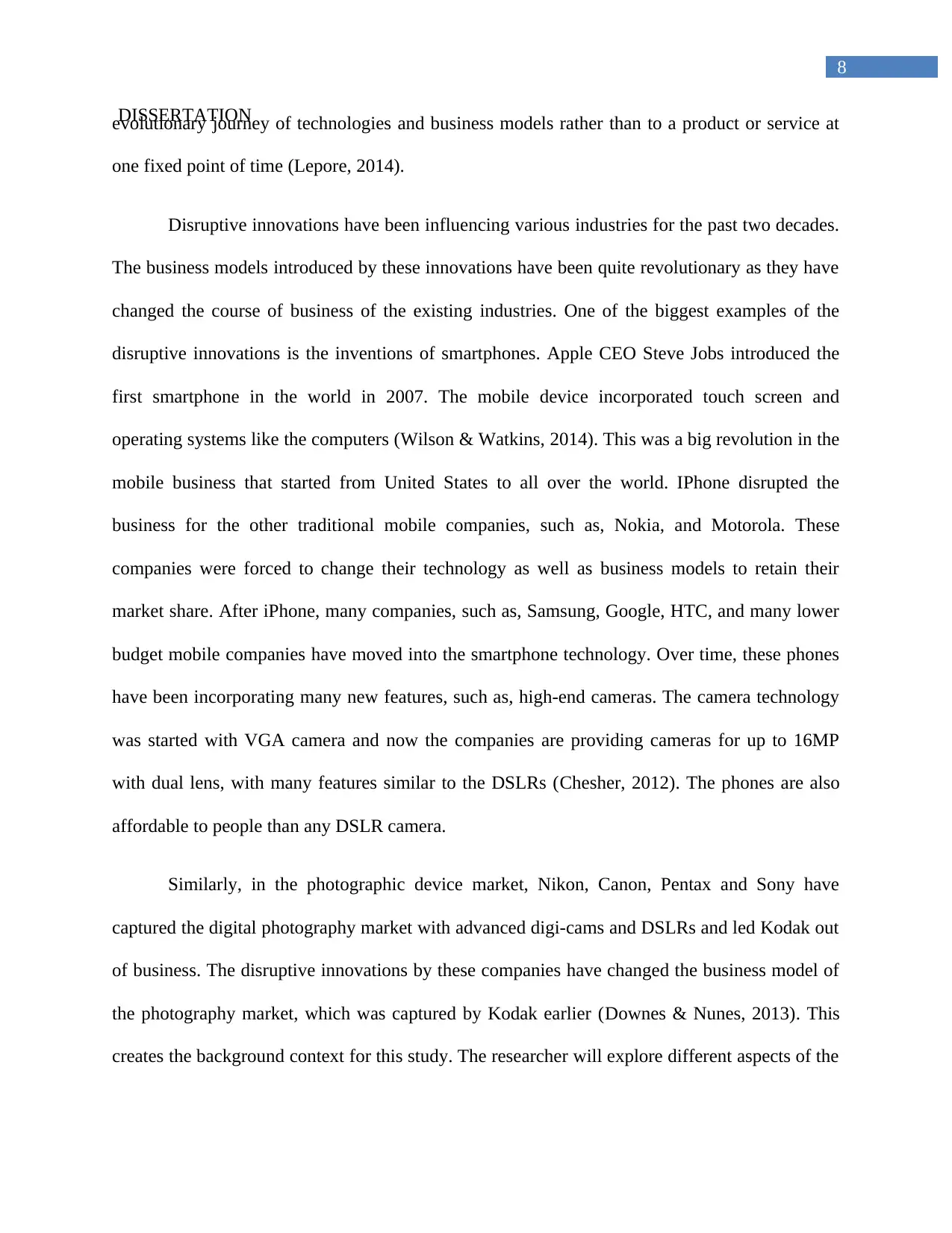
8
DISSERTATIONevolutionary journey of technologies and business models rather than to a product or service at
one fixed point of time (Lepore, 2014).
Disruptive innovations have been influencing various industries for the past two decades.
The business models introduced by these innovations have been quite revolutionary as they have
changed the course of business of the existing industries. One of the biggest examples of the
disruptive innovations is the inventions of smartphones. Apple CEO Steve Jobs introduced the
first smartphone in the world in 2007. The mobile device incorporated touch screen and
operating systems like the computers (Wilson & Watkins, 2014). This was a big revolution in the
mobile business that started from United States to all over the world. IPhone disrupted the
business for the other traditional mobile companies, such as, Nokia, and Motorola. These
companies were forced to change their technology as well as business models to retain their
market share. After iPhone, many companies, such as, Samsung, Google, HTC, and many lower
budget mobile companies have moved into the smartphone technology. Over time, these phones
have been incorporating many new features, such as, high-end cameras. The camera technology
was started with VGA camera and now the companies are providing cameras for up to 16MP
with dual lens, with many features similar to the DSLRs (Chesher, 2012). The phones are also
affordable to people than any DSLR camera.
Similarly, in the photographic device market, Nikon, Canon, Pentax and Sony have
captured the digital photography market with advanced digi-cams and DSLRs and led Kodak out
of business. The disruptive innovations by these companies have changed the business model of
the photography market, which was captured by Kodak earlier (Downes & Nunes, 2013). This
creates the background context for this study. The researcher will explore different aspects of the
DISSERTATIONevolutionary journey of technologies and business models rather than to a product or service at
one fixed point of time (Lepore, 2014).
Disruptive innovations have been influencing various industries for the past two decades.
The business models introduced by these innovations have been quite revolutionary as they have
changed the course of business of the existing industries. One of the biggest examples of the
disruptive innovations is the inventions of smartphones. Apple CEO Steve Jobs introduced the
first smartphone in the world in 2007. The mobile device incorporated touch screen and
operating systems like the computers (Wilson & Watkins, 2014). This was a big revolution in the
mobile business that started from United States to all over the world. IPhone disrupted the
business for the other traditional mobile companies, such as, Nokia, and Motorola. These
companies were forced to change their technology as well as business models to retain their
market share. After iPhone, many companies, such as, Samsung, Google, HTC, and many lower
budget mobile companies have moved into the smartphone technology. Over time, these phones
have been incorporating many new features, such as, high-end cameras. The camera technology
was started with VGA camera and now the companies are providing cameras for up to 16MP
with dual lens, with many features similar to the DSLRs (Chesher, 2012). The phones are also
affordable to people than any DSLR camera.
Similarly, in the photographic device market, Nikon, Canon, Pentax and Sony have
captured the digital photography market with advanced digi-cams and DSLRs and led Kodak out
of business. The disruptive innovations by these companies have changed the business model of
the photography market, which was captured by Kodak earlier (Downes & Nunes, 2013). This
creates the background context for this study. The researcher will explore different aspects of the
⊘ This is a preview!⊘
Do you want full access?
Subscribe today to unlock all pages.

Trusted by 1+ million students worldwide
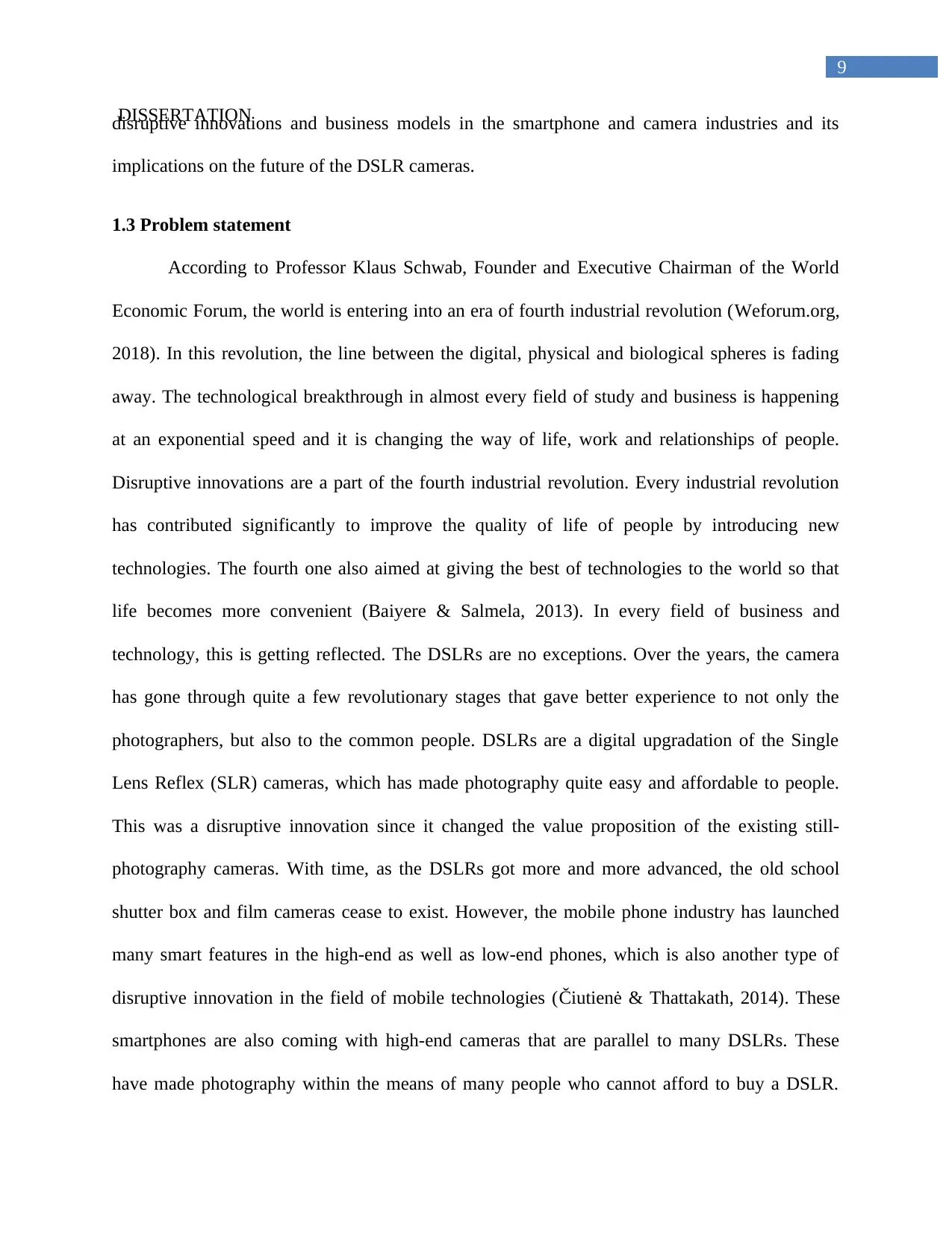
9
DISSERTATIONdisruptive innovations and business models in the smartphone and camera industries and its
implications on the future of the DSLR cameras.
1.3 Problem statement
According to Professor Klaus Schwab, Founder and Executive Chairman of the World
Economic Forum, the world is entering into an era of fourth industrial revolution (Weforum.org,
2018). In this revolution, the line between the digital, physical and biological spheres is fading
away. The technological breakthrough in almost every field of study and business is happening
at an exponential speed and it is changing the way of life, work and relationships of people.
Disruptive innovations are a part of the fourth industrial revolution. Every industrial revolution
has contributed significantly to improve the quality of life of people by introducing new
technologies. The fourth one also aimed at giving the best of technologies to the world so that
life becomes more convenient (Baiyere & Salmela, 2013). In every field of business and
technology, this is getting reflected. The DSLRs are no exceptions. Over the years, the camera
has gone through quite a few revolutionary stages that gave better experience to not only the
photographers, but also to the common people. DSLRs are a digital upgradation of the Single
Lens Reflex (SLR) cameras, which has made photography quite easy and affordable to people.
This was a disruptive innovation since it changed the value proposition of the existing still-
photography cameras. With time, as the DSLRs got more and more advanced, the old school
shutter box and film cameras cease to exist. However, the mobile phone industry has launched
many smart features in the high-end as well as low-end phones, which is also another type of
disruptive innovation in the field of mobile technologies (Čiutienė & Thattakath, 2014). These
smartphones are also coming with high-end cameras that are parallel to many DSLRs. These
have made photography within the means of many people who cannot afford to buy a DSLR.
DISSERTATIONdisruptive innovations and business models in the smartphone and camera industries and its
implications on the future of the DSLR cameras.
1.3 Problem statement
According to Professor Klaus Schwab, Founder and Executive Chairman of the World
Economic Forum, the world is entering into an era of fourth industrial revolution (Weforum.org,
2018). In this revolution, the line between the digital, physical and biological spheres is fading
away. The technological breakthrough in almost every field of study and business is happening
at an exponential speed and it is changing the way of life, work and relationships of people.
Disruptive innovations are a part of the fourth industrial revolution. Every industrial revolution
has contributed significantly to improve the quality of life of people by introducing new
technologies. The fourth one also aimed at giving the best of technologies to the world so that
life becomes more convenient (Baiyere & Salmela, 2013). In every field of business and
technology, this is getting reflected. The DSLRs are no exceptions. Over the years, the camera
has gone through quite a few revolutionary stages that gave better experience to not only the
photographers, but also to the common people. DSLRs are a digital upgradation of the Single
Lens Reflex (SLR) cameras, which has made photography quite easy and affordable to people.
This was a disruptive innovation since it changed the value proposition of the existing still-
photography cameras. With time, as the DSLRs got more and more advanced, the old school
shutter box and film cameras cease to exist. However, the mobile phone industry has launched
many smart features in the high-end as well as low-end phones, which is also another type of
disruptive innovation in the field of mobile technologies (Čiutienė & Thattakath, 2014). These
smartphones are also coming with high-end cameras that are parallel to many DSLRs. These
have made photography within the means of many people who cannot afford to buy a DSLR.
Paraphrase This Document
Need a fresh take? Get an instant paraphrase of this document with our AI Paraphraser
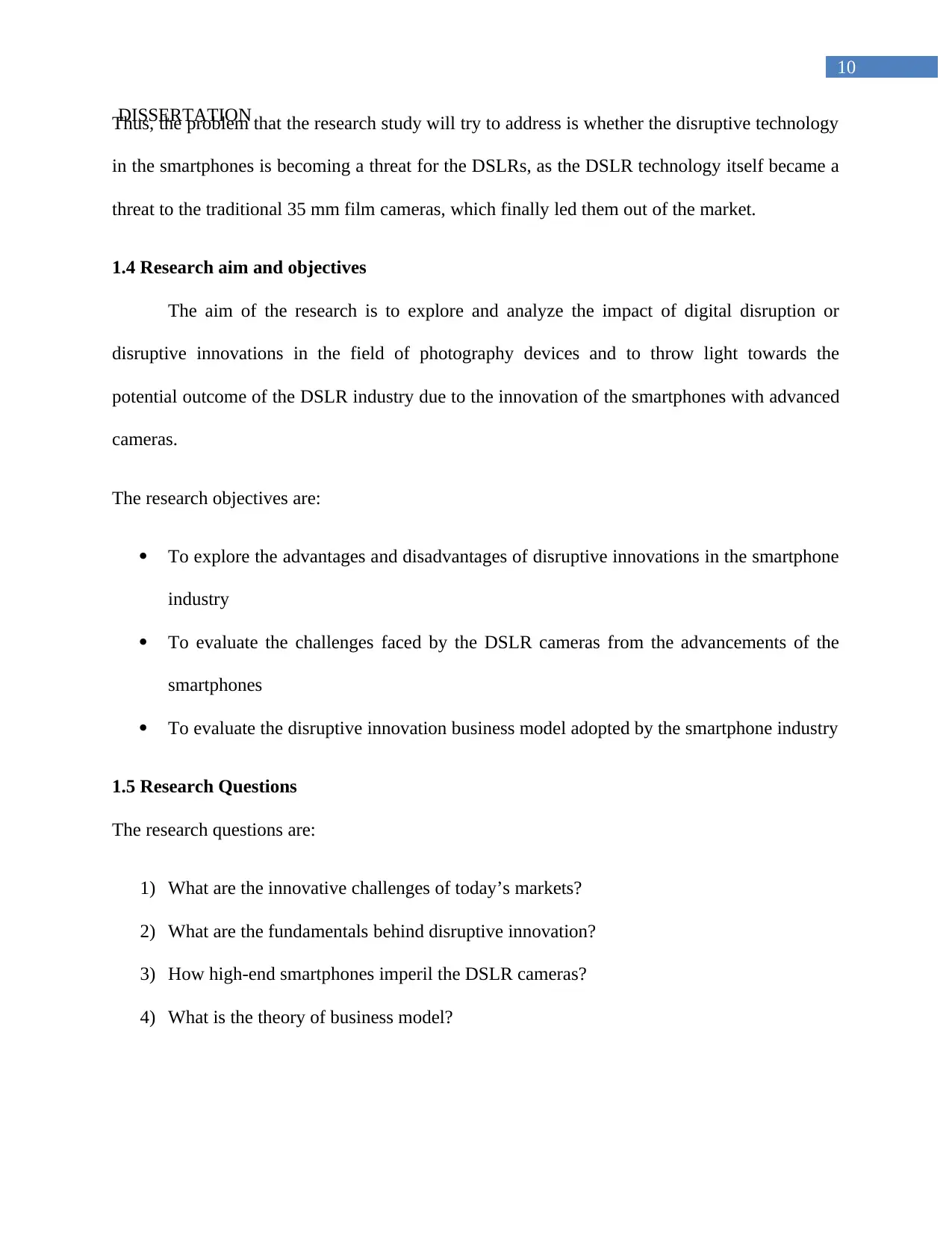
10
DISSERTATIONThus, the problem that the research study will try to address is whether the disruptive technology
in the smartphones is becoming a threat for the DSLRs, as the DSLR technology itself became a
threat to the traditional 35 mm film cameras, which finally led them out of the market.
1.4 Research aim and objectives
The aim of the research is to explore and analyze the impact of digital disruption or
disruptive innovations in the field of photography devices and to throw light towards the
potential outcome of the DSLR industry due to the innovation of the smartphones with advanced
cameras.
The research objectives are:
To explore the advantages and disadvantages of disruptive innovations in the smartphone
industry
To evaluate the challenges faced by the DSLR cameras from the advancements of the
smartphones
To evaluate the disruptive innovation business model adopted by the smartphone industry
1.5 Research Questions
The research questions are:
1) What are the innovative challenges of today’s markets?
2) What are the fundamentals behind disruptive innovation?
3) How high-end smartphones imperil the DSLR cameras?
4) What is the theory of business model?
DISSERTATIONThus, the problem that the research study will try to address is whether the disruptive technology
in the smartphones is becoming a threat for the DSLRs, as the DSLR technology itself became a
threat to the traditional 35 mm film cameras, which finally led them out of the market.
1.4 Research aim and objectives
The aim of the research is to explore and analyze the impact of digital disruption or
disruptive innovations in the field of photography devices and to throw light towards the
potential outcome of the DSLR industry due to the innovation of the smartphones with advanced
cameras.
The research objectives are:
To explore the advantages and disadvantages of disruptive innovations in the smartphone
industry
To evaluate the challenges faced by the DSLR cameras from the advancements of the
smartphones
To evaluate the disruptive innovation business model adopted by the smartphone industry
1.5 Research Questions
The research questions are:
1) What are the innovative challenges of today’s markets?
2) What are the fundamentals behind disruptive innovation?
3) How high-end smartphones imperil the DSLR cameras?
4) What is the theory of business model?
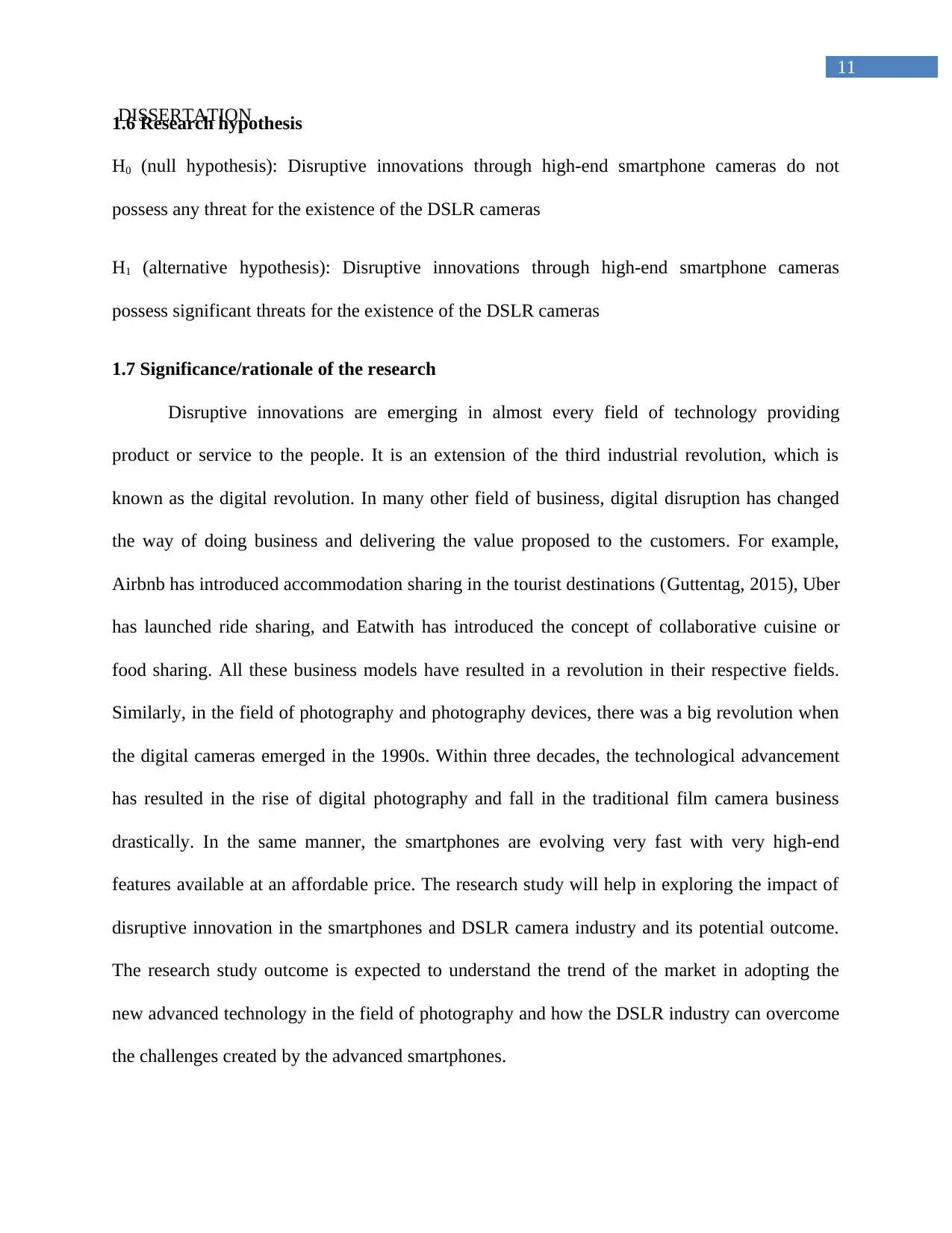
11
DISSERTATION1.6 Research hypothesis
H0 (null hypothesis): Disruptive innovations through high-end smartphone cameras do not
possess any threat for the existence of the DSLR cameras
H1 (alternative hypothesis): Disruptive innovations through high-end smartphone cameras
possess significant threats for the existence of the DSLR cameras
1.7 Significance/rationale of the research
Disruptive innovations are emerging in almost every field of technology providing
product or service to the people. It is an extension of the third industrial revolution, which is
known as the digital revolution. In many other field of business, digital disruption has changed
the way of doing business and delivering the value proposed to the customers. For example,
Airbnb has introduced accommodation sharing in the tourist destinations (Guttentag, 2015), Uber
has launched ride sharing, and Eatwith has introduced the concept of collaborative cuisine or
food sharing. All these business models have resulted in a revolution in their respective fields.
Similarly, in the field of photography and photography devices, there was a big revolution when
the digital cameras emerged in the 1990s. Within three decades, the technological advancement
has resulted in the rise of digital photography and fall in the traditional film camera business
drastically. In the same manner, the smartphones are evolving very fast with very high-end
features available at an affordable price. The research study will help in exploring the impact of
disruptive innovation in the smartphones and DSLR camera industry and its potential outcome.
The research study outcome is expected to understand the trend of the market in adopting the
new advanced technology in the field of photography and how the DSLR industry can overcome
the challenges created by the advanced smartphones.
DISSERTATION1.6 Research hypothesis
H0 (null hypothesis): Disruptive innovations through high-end smartphone cameras do not
possess any threat for the existence of the DSLR cameras
H1 (alternative hypothesis): Disruptive innovations through high-end smartphone cameras
possess significant threats for the existence of the DSLR cameras
1.7 Significance/rationale of the research
Disruptive innovations are emerging in almost every field of technology providing
product or service to the people. It is an extension of the third industrial revolution, which is
known as the digital revolution. In many other field of business, digital disruption has changed
the way of doing business and delivering the value proposed to the customers. For example,
Airbnb has introduced accommodation sharing in the tourist destinations (Guttentag, 2015), Uber
has launched ride sharing, and Eatwith has introduced the concept of collaborative cuisine or
food sharing. All these business models have resulted in a revolution in their respective fields.
Similarly, in the field of photography and photography devices, there was a big revolution when
the digital cameras emerged in the 1990s. Within three decades, the technological advancement
has resulted in the rise of digital photography and fall in the traditional film camera business
drastically. In the same manner, the smartphones are evolving very fast with very high-end
features available at an affordable price. The research study will help in exploring the impact of
disruptive innovation in the smartphones and DSLR camera industry and its potential outcome.
The research study outcome is expected to understand the trend of the market in adopting the
new advanced technology in the field of photography and how the DSLR industry can overcome
the challenges created by the advanced smartphones.
⊘ This is a preview!⊘
Do you want full access?
Subscribe today to unlock all pages.

Trusted by 1+ million students worldwide
1 out of 84
Related Documents
Your All-in-One AI-Powered Toolkit for Academic Success.
+13062052269
info@desklib.com
Available 24*7 on WhatsApp / Email
![[object Object]](/_next/static/media/star-bottom.7253800d.svg)
Unlock your academic potential
Copyright © 2020–2025 A2Z Services. All Rights Reserved. Developed and managed by ZUCOL.





